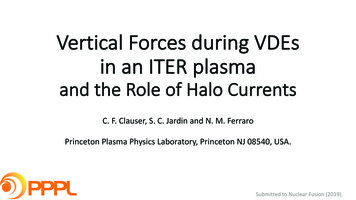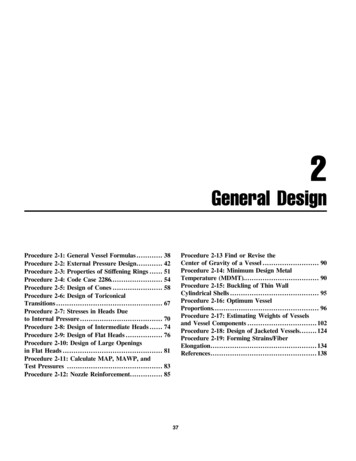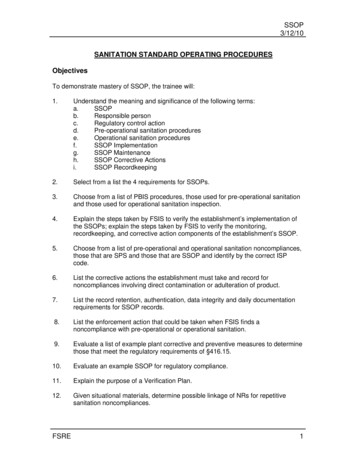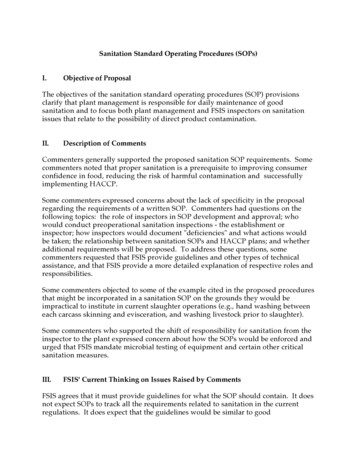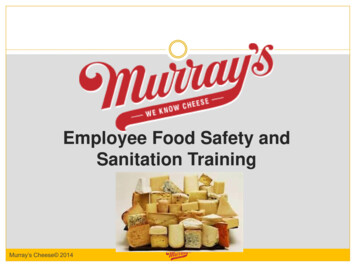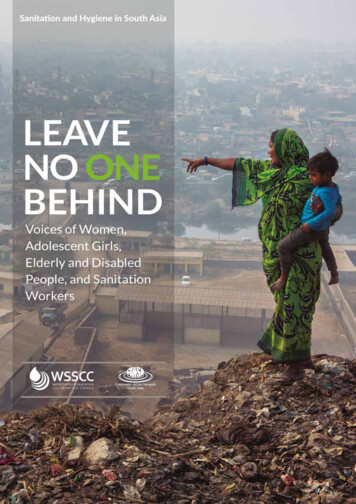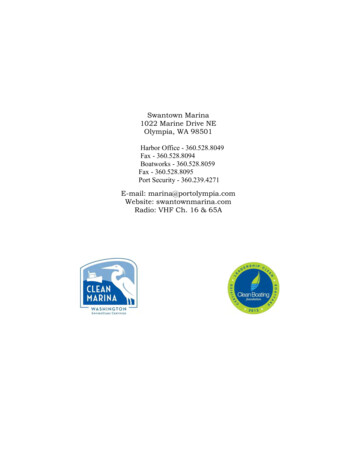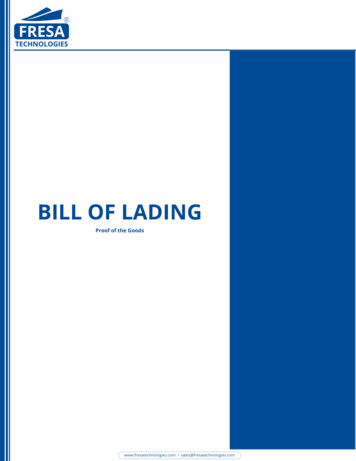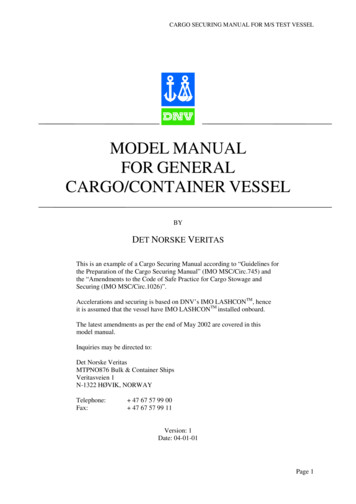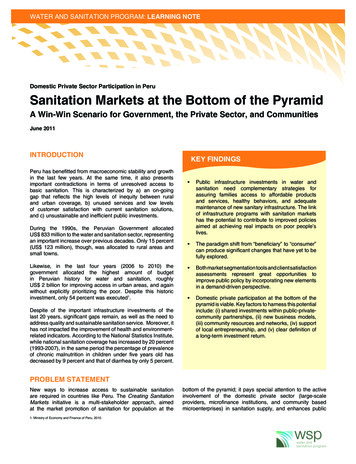
Transcription
U.S. Public Health ServiceCenters for Disease Controland PreventionNational Center for Environmental HealthVessel Sanitation ProgramOperations Manual2000
U.S. Public Health ServiceCenters for Disease Controland PreventionNational Center for Environmental HealthVessel Sanitation ProgramOperations Manual2000CDC / NCEHVessel Sanitation Program4770 Buford Highway NE MS F16Atlanta GA 7CDC / NCEHVessel Sanitation Program1850 Eller Drive - Suite 101Ft. Lauderdale, FL 323-2132www.cdc.gov/nceh/vspvsp@cdc.gov
ForwardThe Centers for Disease Control and Prevention (CDC) established the Vessel SanitationProgram (VSP) in the 1970's as a cooperative activity with the cruise ship industry. Theprogram assists the cruise ship industry in fulfilling its responsibility for developing andimplementing comprehensive sanitation programs in order to minimize the risk ofgastrointestinal diseases. Every vessel that has a foreign itinerary and carries 13 or morepassengers is subject to twice-yearly inspections and, when necessary, reinspection.The VSP operated continuously at all major U.S. ports from the early 1970's through 1986,when CDC terminated portions of the program. Industry and public pressures resulted inCongress directing CDC through specific language included in CDC appropriations to resumethe VSP. The National Center for Environmental Health (NCEH) at CDC became responsiblefor the VSP in 1986.The NCEH held a series of public meetings to determine the needs and desires of the publicand cruise ship industry and on March 1, 1987, a restructured program began. In 1988, theprogram was further modified by introducing user fees to reimburse the U.S. government forcosts. A fee based on the vessel’s size is charged for inspections and reinspections. A VSPOperations Manual based on the FDA 1976 model code for food service and the World HealthOrganization’s Guide to Ship Sanitation was published in 1989 to assist the cruise ship industryin educating shipboard personnel.In 1998, it became apparent that is was time to update the 1989 version of the VSP OperationsManual. Changes in the FDA Food Code, new science on food safety and protection, andnewer technology in the cruise ship industry contributed to the need for a revised OperationsManual. During the past 2 years, the VSP solicited comments from and conducted publicmeetings with representatives of the cruise industry, general public, FDA and internationalpublic health community to ensure that the new manual would appropriately address currentpublic health issues related to cruise ship sanitation.This document is a result of the cooperative effort of many individuals from both governmentand private industry, and the public. We would like to thank all those who submitted commentsand participated throughout this lengthy process. I must also acknowledge the tremendouscommitment of time taken by the VSP staff in drafting this manual. In particular, I mustrecognize Captain Charles Otto as editor and Captain Daniel Harper as the SeniorEnvironmental Health Officer for the VSP. Both were instrumental in the decision to revise the1989 document, and in overseeing the process from start to finish.Although the previous VSP Operations Manual was in use for over 10 years, we know thattechnology and food science will continue to change and evolve. We will continue to reviewthese changes in a public process in an effort to keep the Manual current.The VSP Operations Manual - 2000 continues the 25 year tradition of government and industryworking together to achieve a successful and cooperative Vessel Sanitation Program thatbenefits millions of travelers each year.Dave Forney, ChiefVessel Sanitation ProgramForward2000
Table of 01Page1IntroductionCommunicable Disease PreventionDefinitionsGastrointestinal Illness SurveillancePotable WaterSwimming Pools, Whirlpool Spas, and Hot TubsFood SafetyIntegrated Pest ManagementHousekeepingChild-Activity CentersAdministrative 0-111-112-113-11.0Introduction1-11.1Introduction and Background1-11.2Activities1-11.3Operations Manual1-22.0Communicable Disease Prevention2-12.1Public Health Service 14.0Gastrointestinal Illness Surveillance4-14.1Data Collection4-14.2Notification4-4Original document was printed with a HP Laserjet 4si printer. Actual page numbers mayvary with different printers and their formatting. Blue Hypertext LinksContents - 12000
5.0Potable Water5-15.1Source5-15.2Bunker and Production Halogenation5-25.3Potable Water System5-35.4Potable Water System Halogenation5-75.5Potable Water System Halogen Monitoring5-75.6Microbiologic Monitoring5-95.7Water Distribution System Protection6.0Swimming Pools and Whirlpool Spas6-16.1Flow -Through Seawater Swimming Pools6-16.2Recirculating Swimming Pools6-26.3Whirlpool Spas6-36.4Safety6-57.0Food 4Equipment and Utensils7-277.5Warewashing and Laundering7-387.6Poisonous and Toxic Materials7-517.7Facilities7-558.0Integrated Pest Management8-18.1Integrated Pest Management8-18.2Pest Control8-2Contents - 25-102000
9.0Housekeeping9-19.1Infection-Control Procedures9-19.2Air Systems9-19.3Fountains, Humidifiers, and Showers9-210.0Child-Activity Centers10-110.1Diaper Changing10-110.2Toilet and Handwashing10-210.3Cleaning and ve Guidelines11-111.1Inspections11-111.2Inspection Report11-211.3Risk-Based Scoring and Correction Priority11-311.4Closing Conference11-411.5Inspection Review11-411.6Corrective-Action Statement11-611.7Correction Affidavit11-711.8Inspection Publication11-811.9Recommendation that the Vessel Not Sail11-811.10Reinspections and Follow-Up Inspections11-911.11Construction / Renovation Inspections11-1011.12Other Environmental 1Contents - 32000
13.0Annexes13-113.1Authority13.2Gastrointestinal Illness Surveillance System13.3Gastrointestinal Illness Surveillance SystemReporting13.4Gastrointestinal Illness Outbreak Investigation13.5Disinfection Calculations for Water and Equipment13.6Food Cooking Alternatives13.7Warewashing Evaluation13.8Inspection Report13.9Corrective Action Statement13.10Summary of Sanitation Inspections of InternationalCruise Ships13.11BibliographyContents - 42000
INFORMATION TO ASSIST THE USER ON MANUALFORMATorganizationThe Vessel Sanitation Program Operations Manual isdivided into chapters and then sections that focus on eachoperational area important to safeguarding public healthaboard vessels.keywordsEach of the guidelines is formated with a keyword orphrase on the left side of the page to assist the user inquickly locating a specific section.section numberThe international numbering system is used to organizethe guidelines in this document.descriptionThe public health compliance recommendation is providedin this statement.italicsPortions of some sections of these guidelines are writtenin italics. These provisions are not requirements, but areprovided to convey relevant information about specificexceptions and alternative means for compliance.inspection reportnumberThe individual inspection report item number that will befound in violation if this recommendation is not followed isshown to the right of the description.criticalsCritical compliance items are designated in theseguidelines with a C to the right of the inspection reportnumber which is also highlighted in red along with thesection number.noncritical itemsNoncritical compliance items are the other items in thismanual.Contents - 52000
1.0Introduction1.11.21.3Introduction and BackgroundActivitiesOperations Manual1.1Introduction and Background1.1.1Cooperative Activityhistory1.1.1.1The Centers for Disease Control and Prevention (CDC)established the Vessel Sanitation Program (VSP) in 1975,as a cooperative activity with the cruise ship industry. Thisprogram assists the cruise ship industry in fulfilling itsresponsibility for developing and implementingcomprehensive performance-based systems to protect thehealth of the traveling public.cooperation1.1.1.2The program fosters cooperation between the cruise shipindustry and government to define and reduce health risksassociated with vessels and to ensure a healthful andclean environment for vessels’ passengers and crew. Theindustry’s aggressive and ongoing efforts to achieve andmaintain high standards of food safety and environmentalsanitation are critical to the success of protecting ns1.2.1.1The VSP conducts a comprehensive food safety andenvironmental sanitation inspection on vessels that have aforeign itinerary, call on a U.S. port, and carry 13 or morepassengers.surveillance1.2.1.2The program conducts ongoing surveillance ofgastrointestinal illness and coordinates / conductsoutbreak investigations on vessels.20001-1
1.2.2Informationtraining1.2.2.1The VSP provides food safety and environmentalsanitation training seminars for vessel and shoreoperations management personnel.plan review1.2.2.2The program provides consultative services for reviewingplans for renovations and new construction.constructioninspections1.2.2.3The program conducts construction inspections at theshipyards and when the vessel makes its initial call at aU.S. port.information1.2.2.4The program disseminates information to the public.1.3Operations Manual1.3.1Revisionsmanual1.3.1.1The Operations Manual for the VSP has been modified asa result of emerging public health issues, industryrecommendations, introduction of new technologies withinthe industry, new guidance from sources used in theprevious edition, and CDC’s experience.programguidance1.3.1.2The program operations and inspections are based on thismanual.periodicreview1.3.1.3The Operations Manual will be reviewed annually in thepublic meeting with written submissions for revision basedon emerging public health issues and new technologiesthat may better address the public health issues onvessels.20001-2
2.0Authority2.1Public Health Service Act2.1Public Health Service Act2.1.1Communicable Disease Preventioncommunicable diseaseprevention2.1.1.1Although cooperation by vessels with the VSP isvoluntary, the Public Health Service (PHS) is authorizedby the Public Health Service Act (42 U.S.C. Section 264.Quarantine and Inspection - Regulations to controlcommunicable diseases) to take measures necessary toprevent the introduction, transmission, or spread ofcommunicable diseases into the United States from aforeign country.regulationpromulgation2.1.1.2In addition, the Public Health Service Act (42 U.S.C.Section 269. Quarantine and Inspection - Bills of health.)authorizes the promulgation of regulations applicable tovessels for preventing the introduction into the UnitedStates of "any communicable disease by securing the bestsanitary condition of such vessels, their cargoes,passengers, and crews."inspections2.1.1.3Regulations promulgated to carry out these dutiesauthorize the PHS to conduct sanitary inspections oncarriers traveling to a U.S. port from a foreign area (42CFR Section 71.41. General Provisions. ForeignQuarantine - Requirements Upon Arrival at U.S. Ports:Sanitary Inspection). This purpose of the inspection is todetermine the existence of vermin, contaminated food orwater, or other insanitary conditions that may contribute tothe introduction, spread, or transmission of communicabledisease.2-12000
efinitions provided in the Operations Manual areprovided to clarify terminology commonly used in publichealth.3.1.2The terms defined are shown in relation to OperationsManual chapters where they are used, but they may alsopertain to other chapters in this manual.3.2DefinitionsAuthority"USPHS or PHS" means the U.S. Public Health Service.Potable Water"Air-break" means a piping arrangement in which a drainfrom a fixture, appliance, or device discharges indirectlyinto another fixture, receptacle, or interceptor at a pointbelow the flood-level rim."Air-gap" means the unobstructed vertical distancethrough the free atmosphere between the lowest openingfrom any pipe or faucet supplying water to a tank,plumbing fixture, or other device and the flood-level rim ofthe receptacle or receiving fixture. The air gap must be atleast twice the diameter of the supply pipe or faucet or atleast 3 cm (1 inch), whichever is greater."Atmospheric vacuum breaker" means an approvedbackflow prevention device that is necessary on a potablewater outlet designed for an attachment that does nothave a shutoff downstream from the attachment topreclude the possibility of backflow."Backflow" means the flow of water or other liquids,3-12000
mixtures, or substance into the distribution pipes of apotable supply of water from any source or sources otherthan the source of potable water supply. Back-siphonageis one form of backflow."Backflow, check, or non-return valve" means amechanical device installed in a waste line to prevent thereversal of flow under conditions of back pressure. In thecheck valve type, the flap should swing into a recess whenthe line is flowing full, to preclude obstructing the flow."Backflow preventer" means an approved backflowprevention device that is necessary on a potable wateroutlet."Back-siphonage" means the flowing back of used,contaminated, or polluted water from a plumbing fixture orvessel or other source into a water supply pipe as a resultof negative pressure in the pipe."Black water" means wastewater from water closets(toilets)."Cross-connection" means any physical connectionbetween two otherwise separate piping systems thatallows a flow from one system to the other."Gray water" means all domestic wastewater includingwater from showers, sinks, laundry, and equipment drains,but not wastewater from toilets."Halogen" means the group of elements includingfluorine, chlorine, bromine, and iodine used for thedisinfection of water."Harbor area" means that portion of a harbor set asidefor vessel anchorage or for ports including wharves, piers,quays, and service areas, the boundaries are the highwater shore line, and others as determined by legaldefinition, citation of coordinates, or other means."Hose connection vacuum breaker" means anapproved backflow preventer that attaches directly to ahose bib, has a single check with an atmospheric vent andis not designed for continuous pressure applications."mg/L" means milligrams per liter, which is the metricequivalent of parts per million (ppm)."Non-potable fresh water (Technical water)" means3-22000
fresh water intended for laundry use or for washing decksin areas other than the vessel’s hospital or food serviceand food storage areas."Pollution" means the presence in water of any foreignsubstance (organic, inorganic, radiologic, or biologic) thattends to degrade water quality to create a health hazard."Potable water" means fresh water intended for drinking,washing, bathing, or showering; for use in the vessel’shospital; for handling, preparing, or cooking food; and forcleaning food storage and preparation areas, utensils, andequipment."Potable water tanks" means all tanks into which potablewater is bunkered or produced for distribution and fromwhich it is used as potable water."Reduced pressure backflow preventer" means anapproved backflow device used in high hazard situationsthat has two independent check valves with anintermediate vacuum breaker and relief valve."Sewage" means any liquid waste containing animal orvegetable matter in suspension or solution, includingliquids containing chemicals in solution."Specialty backflow preventer" means an approvedbackflow device used in low hazard situations that has twoindependent check valves with an intermediate vacuumbreaker and relief valve.Food SafetyAdditive.(a) "Food additive" has the meaning stated in theFederal Food, Drug, and Cosmetic Act, §201(s) and 21CFR 170.(b) "Color additive" has the meaning stated in theFederal Food, Drug, and Cosmetic Act, §201(t) and 21CFR 70."Adulterated" has the meaning stated in the FederalFood, Drug, and Cosmetic Act, §402."Approved" means acceptable to the VSP based on adetermination of conformity with principles, practices, andgenerally recognized standards that protect public health3-32000
such as ANSI/NSF standards, ASSE standards, federalregulations or equivalent international standards andregulations."aw" means water activity which measures the freemoisture in a food. It is the quotient of the water vaporpressure of the substance divided by the vapor pressureof pure water at the same temperature."Beverage" means a liquid for drinking, including water."Bottled drinking water" means water that is sealed inbottles, packages, or other containers and offered for saleand that is safe for human consumption, including bottledmineral water."Certification number" means a unique combination ofletters and numbers assigned by a shellfish-controlauthority to a molluscan shellfish dealer according to theprovisions of the National Shellfish Sanitation Program."CIP" means cleaned in place by circulating or flowingmechanically through a piping system of a detergentsolution, water rinse, and sanitizing solution onto or overequipment surfaces that require cleaning, such as themethod used, in part, to clean and sanitize a frozendessert machine."CIP" does not include the cleaning of EQUIPMENT such asband saws, slicers, or mixers that are subjected to inplace manual cleaning without the use of a CIP system."CFR" means Code of Federal Regulations. Citations inthis Code to the CFR refer sequentially to the Title, Part,and Section numbers, such as 21 CFR 178.1010 refers toTitle 21, Part 178, Section 1010."Code of Federal Regulations" means the compilation ofthe general and permanent rules published in the FederalRegister by the executive departments and agencies ofthe federal government which:(a) Is published annually by the U.S. Government PrintingOffice; and(b) Contains FDA rules in 21 CFR, USDA rules in 7 CFRand 9 CFR, EPA rules in 40 CFR, and Wildlife andFisheries rules in 50 CFR.3-42000
"Comminuted" means reduced in size by methodsincluding chopping, flaking, grinding, or mincing."Comminuted" includes fish or meat products that arereduced in size and restructured or reformulated such asgefilte fish, gyros, ground beef, and sausage; and amixture of 2 or more types of meat that have beenreduced in size and combined, such as sausages madefrom 2 or more meats."Confirmed disease outbreak" means a foodborne orwaterborne disease outbreak in which laboratory analysisof appropriate specimens identifies a causative agent andepidemiologic analysis implicates the food or water as thesource of the illness."Consumer" means a person who is a member of thepublic, takes possession of food, is not functioning in thecapacity of an operator of a food establishment or foodprocessing plant, and does not offer the food for resale."Corrosion-resistant material" means a material thatmaintains acceptable surface cleanability characteristicsunder prolonged influence of the food to be contacted, thenormal use of cleaning compounds and sanitizingsolutions, and other conditions of the environment wherethe material is used."Critical-control point" means a point or procedure in aspecific food system where loss of control may result in anunacceptable health risk."Critical limit" means the maximum or minimum value ata critical-control point to which a physical, biologic, orchemical parameter must be controlled to minimize theoccurrence of risk from an identified food safety hazard."Drinking water" means water that meets 40 CFR 141National Primary Drinking Water Regulations."Drinking water" is traditionally known as "potablewater.""Drinking water" includes the term "water" except wherethe term used connotes that the water is not potable, suchas "boiler water," "mop water," "rainwater," "wastewater,"and "nondrinking" water."Dry-storage area" means a room or area designated for3-52000
the storage of packaged or containerized bulk food that isnot potentially hazardous and dry goods such as singleservice items."Easily cleanable" means a characteristic of a surfacethat:(a) Allows effective removal of soil by normal cleaningmethods;(b) Is dependent on the material, design, construction, andinstallation of the surface; and(c) Varies with the likelihood of the surface's role inintroducing pathogenic or toxigenic agents or othercontaminants into food based on the surface's approvedplacement, purpose, and use."Easily cleanable" includes a tiered application of thecriteria that qualify the surface as easily cleanable asspecified under Subparagraph (a) of this definition todifferent situations in which varying degrees of cleanabilityare required such as:(a) The appropriateness of stainless steel for a foodpreparation surface, compared with the lack of need forstainless steel to be used for floors or for tables used forconsumer dining; or(b) The need for a different degree of cleanability for autilitarian attachment or accessory in the kitchen,compared with a decorative attachment or accessory inthe consumer dining area."Easily movable" means:(a) Portable; mounted on casters, gliders, or rollers; orprovided with a mechanical means to safely tilt a unit ofequipment for cleaning; and(b) Having no utility connection, a utility connection thatdisconnects quickly, or a flexible utility connection line ofsufficient length to allow the equipment to be moved forcleaning of the equipment and adjacent area."EPA" means the U.S. Environmental Protection Agency."Equipment" means an article used in the operation of a3-62000
food establishment, such as a freezer, grinder, hood, icemaker, meat block, mixer, oven, reach-in refrigerator,scale, sink, slicer, stove, table, temperature measuringdevice for ambient air, vending machine, or warewashingmachine."Equipment" does not include items used for handling orstoring large quantities of packaged foods that arereceived from a supplier in a cased or overwrapped lot,such as hand trucks, forklifts, dollies, pallets, racks, andskids."Fish" means fresh or saltwater finfish, crustaceans, andother forms of aquatic life (including alligator, frog, aquaticturtle, jellyfish, sea cucumber, and sea urchin and the roeof such animals) other than birds or mammals, and allmollusks, if such animal life is intended for humanconsumption."Fish" includes an edible human food product derived inwhole or in part from fish, including fish that have beenprocessed in any manner."Food" means a raw, cooked, or processed ediblesubstance, ice, beverage, or ingredient used or intendedfor use or for sale in whole or in part for humanconsumption, or chewing gum."Foodborne disease outbreak" means an incident inwhich:(a) 2 or more nonrelated persons experience a similarillness after ingesting a common food; and(b) Epidemiologic analysis implicates the food as thesource of the illness."Foodborne disease outbreak" also includes a singlecase of illness such as 1 person ill from botulism orchemical poisoning."Food-contact surface" means:(a) A surface of equipment or a utensil with which foodnormally comes into contact; or(b) A surface of equipment or a utensil from which foodmay drain, drip, or splash into a food, or onto a surface3-72000
normally in contact with food."Food employee" means a person working withunpackaged food, food equipment or utensils, or foodcontact surfaces."Food-processing plant" means a commercial operationthat manufactures, packages, labels, or stores food forhuman consumption and does not provide food directly toa consumer."Game animal" means an animal, the products of whichare food, that is not classified as cattle, sheep, swine,goat, horse, mule, or other equine in 9 CFR Subchapter A- Mandatory Meat Inspection, Part 301, as Poultry in 9CFR Subchapter C - Mandatory Poultry ProductsInspection, Part 381, or as fish as defined underSubparagraph 1-201.10(B)(25)."Game animal" includes mammals such as reindeer, elk,deer, antelope, water buffalo, bison, rabbit, squirrel,opossum, raccoon, nutria, or muskrat, and nonaquaticreptiles such as land snakes."Game animal" does not include ratites such as ostrich,emu, and rhea."Grade A standards" means the requirements of thePHS/FDA "Grade A Pasteurized Milk Ordinance" and"Grade A Condensed and Dry Milk Ordinance" with whichcertain fluid and dry milk and milk products comply."General-use pesticide" means a pesticide that is notclassified by EPA for restricted use as specified in 40 CFR152.175."HACCP plan" means a written document that delineatesthe formal procedures for following the Hazard AnalysisCritical Control Point principles developed by The NationalAdvisory Committee on Microbiological Criteria for Foods."Hazard" means a biologic, chemical, or physical propertythat may cause an unacceptable consumer health risk."Hermetically sealed container" means a container thatis designed and intended to be secure against the entry ofmicroorganisms and, in the case of low-acid cannedfoods, to maintain the commercial sterility of its contentsafter processing.3-82000
"Imminent health hazard" means a significant threat ordanger to health that is considered to exist when evidenceis sufficient to show that a product, practice, circumstance,or event creates a situation that requires immediatecorrection or cessation of operation to prevent injurybased on the number of potential injuries, and the nature,severity, and duration of the anticipated injury."Injected" means manipulating a meat so that infectiousor toxigenic microoganisms may be introduced from itssurface to its interior through tenderizing with deeppenetration or injecting the meat such as with juices whichmay be referred to as "injecting," "pinning," or "stitchpumping.”"Kitchenware" means food preparation and storageutensils."Law" means applicable local, state, federal, or otherequivalent international statutes, regulations, andordinances."Linens" means fabric items such as cloth hampers, clothnapkins, table cloths, wiping cloths, and work garmentsincluding cloth gloves."Meat" means the flesh of animals used as food includingthe dressed flesh of cattle, swine, sheep, or goats andother edible animals, except fish, poultry, and wild gameanimals."Molluscan shellfish" means any edible species of freshor frozen oysters, clams, mussels, and scallops or edibleportions thereof, except when the scallop product consistsonly of the shucked adductor muscle."Packaged" means bottled, canned, cartoned, securelybagged, or securely wrapped, whether packaged in a foodestablishment or a food-processing plant."Packaged" does not include a wrapper, carry-out box, orother nondurable container used to containerize food tothe facilitate food protection during service and receipt ofthe food by the consumer."Person in charge" means the individual present on avessel who is responsible for the food operation at thetime of inspection such as the Food and BeverageManager, Food Manager, or Chef.3-92000
"Personal-care items" means items or substances thatmay be poisonous, toxic, or a source of contamination andare used to maintain or enhance a person's health,hygiene, or appearance."Personal-care items" include items such as medicines;first aid supplies; and other items such as cosmetics, andtoiletries such as toothpaste and mouthwash."pH" means the symbol for the negative logarithm of thehydrogen ion concentration, which is a measure of thedegree of acidity or basicity of a solution.Values between 0 and 7 indicate acidity and valuesbetween 7 and 14 indicate alkalinity. The value for puredistilled water is 7, which is considered neutral."Physical facilities" means the structure and interiorsurfaces of a vessel’s food storage, preparation andservice areas, including accessories such as soap andtowel dispensers, and attachments, such as light fixturesand heating or air conditioning system vents."Plumbing fixture" means a receptacle or device that:(a) Is permanently or temporarily connected to the waterdistribution system of the vessel and demands a supply ofwater from the system; or(b) Discharges used water, waste materials, or sewagedirectly or indirectly to the drainage system of the vessel."Plumbing system" means the water supply anddistribution pipes; plumbing fixtures and traps; soil, waste,and vent pipes; sanitary sewer drains and vessel drains,including their respective connections, devices, andappurtenances within the vessel; and water-treatingequipment."Poisonous or toxic materials" means substances thatare not intended for ingestion and are included in 4categories:(a) Cleaners and sanitizers, which include cleaning andsanitizing agents and agents such as caustics, acids,drying agents, polishes, and other chemicals;(b) Pesticides except sanitizers, which include substances3-102000
such as insecticides and rodenticides;(c) Substances necessary for the operation andmaintenance of the establishment such as nonfood-gradelubricants and personal care items that may bedeleterious to health; and(d) Substances that are not necessary for the operationand maintenance of the vessel and are on the vessel,such as petroleum products and paints."Potentially hazardous food" means a food that isnatural or synthetic and that requires temperature controlbecause it is in a form capable of supporting:(a) The rapid and progressive growth of infectious ortoxigenic microorganisms;(b) The growth and toxin production of Clostridiumbotulinum; or(c) In raw shell eggs, the growth of Salmonellaenteritidis."Potentially hazardous food" includes an animal food (afood of animal origin) that is raw or heat-treated; a food ofplant origin that is heat-treated or consists of raw seedsprouts; cut melons; and garli
Program (VSP) in the 1970's as a cooperative activity with the cruise ship industry. The program assists the cruise ship industry in fulfilling its responsibility for developing and implementing comprehensive sanitation programs in order to minimize the risk of gastrointestinal diseases. Every vessel that has a foreign itinerary and carries 13 .
